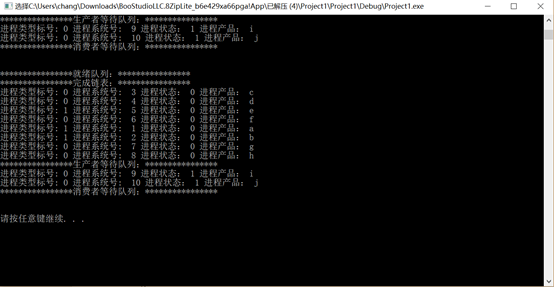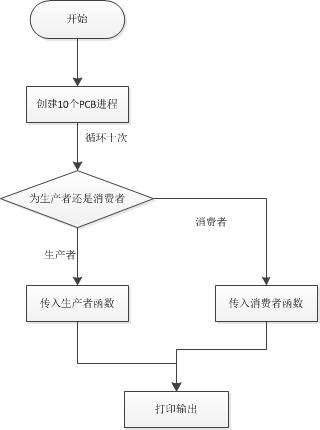为了这个实验二,资料查了巨多,pv操作什么的好不容易弄明白了,但是感觉老师要求的好像用不到这个。
大部分都是某位同学的成果哈哈哈。
自己总结了一下:
1.队列和链表在c++中是可以直接用已经有的模板的。
2.学会用指针进行遍历。
3.消费者要是能放到buffer里就看生产者等待队列里有没有人,有人就唤醒一个生产者。
4.要是buffer只有1那么大,最终完成链表中必定是生产者和消费者交替,这是一个验证程序对错的方法。
#include<iostream>
#include<queue>
#include<list>
#include<cstdlib>
#include<ctime>
using namespace std;
typedef struct
{
int type;//进程类型标号 0 生产者 1位消费者
int ID;//进程系统号 1-10
int state;//进程状态 0就绪 1等待 2完成
char product;//进程产品 字符
}PCB;
int buffersize = 2;//缓冲区大小
queue<PCB>ready;
queue<PCB>producerwait;//生产者等待队列
queue<PCB>consumerwait;//消费者等待队列
list<PCB>over;//收集已经运行结束的进程
int buffercount = 0;
int buffer[3];
void Producer(PCB &p)
{
if (buffercount < 2)
{
buffercount++;
buffer[buffercount] = p.ID;
if (!consumerwait.empty())
{
PCB temp;
temp = consumerwait.front();
temp.state = 0;
ready.push(temp);
consumerwait.pop();
}
over.push_back(p);
p.state = 2;
}
else
{
p.state = 1;
producerwait.push(p);
}
}
void Consumer(PCB &p)
{
if (buffercount != 0)
{
buffer[buffercount] = NULL;
buffercount--;
over.push_back(p);
if (!producerwait.empty())
{
PCB temp;
temp = producerwait.front();
temp.state = 0;
ready.push(temp);
producerwait.pop();
}
p.state = 2;
}
else
{
p.state = 1;
consumerwait.push(p);
}
}
int main()
{
PCB p[10];
for (int i = 0; i < 10; i++)//对模块进行初始化
{
p[i].type = rand() % 2;
p[i].ID = i + 1;
p[i].state = 0;
p[i].product = 'a'+i;
ready.push(p[i]);
}
while (!ready.empty())
{
PCB t;
t = ready.front();
ready.pop();
if (t.type == 0)//如果是生产者
{
Producer(t);
}
else
{
Consumer(t);
}
cout << "****************就绪队列:****************" << endl;
queue<PCB>_ready;
_ready = ready;
while (!_ready.empty())
{
PCB te = _ready.front();
cout <<"进程类型标号: "<< te.type<<" 进程系统号: "<<te.ID<<" 进程状态: "<<te.state<<" 进程产品: "<<te.product<<" " << endl;
_ready.pop();
}
cout << "****************完成链表:****************" << endl;
std::list<PCB>::iterator iter;
std::list<PCB>::iterator start = over.begin();
for(iter=over.begin();iter!=over.end();iter++)
{
PCB p = *iter;
cout << "进程类型标号: " << p.type << " 进程系统号: " << p.ID << " 进程状态: " << p.state << " 进程产品: " << p.product << " " << endl;
}
cout << "****************生产者等待队列:****************" << endl;
queue<PCB>_producerwait;
_producerwait = producerwait;
while (!_producerwait.empty())
{
PCB te = _producerwait.front();
cout << "进程类型标号: " << te.type << " 进程系统号: " << te.ID << " 进程状态: " << te.state << " 进程产品: " << te.product << " " << endl;
_producerwait.pop();
}
cout << "****************消费者等待队列:****************" << endl;
queue<PCB>_consumerwait;
_consumerwait = consumerwait;
while (!_consumerwait.empty())
{
PCB te = _consumerwait.front();
cout << "进程类型标号: " << te.type << " 进程系统号: " << te.ID << " 进程状态: " << te.state << " 进程产品: " << te.product << " " << endl;
_consumerwait.pop();
}
cout << endl;
cout << endl;
}
system("pause");
return 0;
}最终结果图

自己画的自己理解的流程图


ps前一段时间学校oj竟更新了,原以为储存在学校网站和安全啊,我的数据结构代码啊,伤心,看来一定要多备份!
最后
以上就是可靠手机最近收集整理的关于操作系统实验二总结(生产者消费者问题)的全部内容,更多相关操作系统实验二总结(生产者消费者问题)内容请搜索靠谱客的其他文章。
本图文内容来源于网友提供,作为学习参考使用,或来自网络收集整理,版权属于原作者所有。








发表评论 取消回复